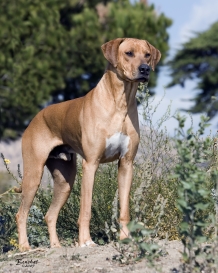CH. Lamarde Perro
Sir Lancelot

All information on this site is the property of Lamarde Perro Kennels and their respective
authors. Nothing on this site may be copied, redistributed or re-
Rhodesian Ridgeback Breeder

The Rhodesian Ridgeback Dog
At this time, the Rhodesian Ridgeback dog is the only registered breed indigenous to southern Africa.
The original standard was constructed by F.R. Barnes in 1922, and was accepted by
the South African Kennel Union in 1926. With the direction and help of Ridgeback
fanciers -
The overall appearance of the Rhodesian Ridgeback dog (Formerly the "African Lion Hound", or the "Van Rooyen Lion Dog") is one of charisma, strength and poise. He should be well muscled, with apparent agility and grace coupled with power. This breed is not considered "pretty", but rather it is said to be "handsome" with a look of noble character. Frequently you will hear of him spoken of as regal, or austere in temperament and personality.
The hallmark of the breed is a neat, symmetrically balanced ridge of hair growing in the opposite direction to the rest of the coat. It starts in the middle of the shoulder blade area, where there should be a symmetrical fan with two whorls (Swirls) of hair on either side of the ridge. From here the "ridge" should proceed neatly along the spine all the way to the front of the croupe (Rear) tapering gently until it ends in a point.
It is possible, and in fact, there is a 2% probability that a Rhodesian Ridgeback dog can be born without a ridge. This shouldn't be considered a health issue, nor is it an aberration. It is simply in the genes due to the fact that its early history there are ridgeless dogs. Reputable breeders will not breed ridgeless dogs as the ultimate goal is to eliminate ridgelessness altogether.
There is a health concern called "Dermoid Sinus" which, can be present at birth. It is important to understand that this defect does not "suddenly appear" one day. If a Rhodesian Ridgeback has this problem, it will be detectable almost at birth to an experienced breeder. Most of the time a surgical procedure can be effected and there is no noticable problem with the animal. Reputable breeders have this surgery performed prior to placing a puppy. These dogs make fine pets and usually the surgery is undetectable. However, in an effort to protect the gene pool, no dog with such a defect should ever be bred.
The ridge is said to have derived from a dog from the South of Africa, where it was domesticated by a tribe of people dubbed by the early European settlers as the "Hottentots". One such dog was unearthed at a place called "Orange River" South Africa by archaeologists where they discovered the remains of a dog where the Ridge was clearly discernable.
Eventually, the Rhodesian Ridgeback dog became revered because of its hardiness in the harsh African Veldt, and soon the Europeans began trying various crosses, perfecting the breed for their own needs.
A few notable people began focusing on shaping the breed for hunting big game, mostly Lion. The rigors of African life required an extremely versatile dog, smart enough to protect itself from danger and at the same time, courageous enough to defend life and property, if need be. Thus, the Rhodesian Ridgeback dog was born.